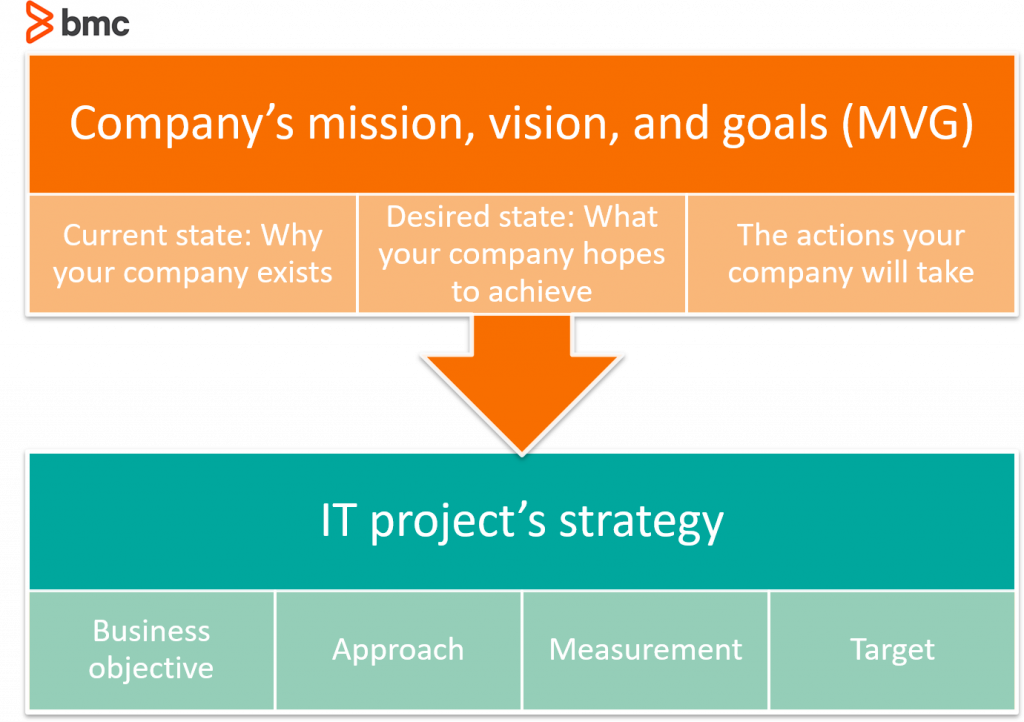Strategy is vital to a successful IT project. Your strategy should ensure the IT project aligns with the company’s vision, so that the outcomes support direct business goals. A strategy guides project managers to design milestones that fulfill specific business objectives at each project stage.
But how do you go about being strategic? What components must you consider? Fortunately, there is guidance. A strategy framework can help you consider a variety of aspects and components of your proposed IT project, helping you reach well-informed decisions during the planning and execution processes.
IT project managers won’t want to miss this article—we’re exploring IT strategy frameworks that align with your company’s mission, vision, and goals (MVG). We’ll define strategic frameworks for IT, share use cases and benefits, and point you to the most popular models for strategic frameworks.
What is a strategic framework for IT?
A strategic framework is a systematic, structured method that helps you define how your IT project (or initiative) supports business goals and stakeholder objectives.
Think of a chemistry or math equation, where you must account for the right mix of variables to produce the expected outcome. A strategic framework is similar—you piece together the relationships and resources and activities needed to create a valuable business outcome, then you document it.
The purpose of an IT strategy framework is to provide general, macro-level propositions about the project’s content. As a result, teams can evaluate their IT strategy before implementing and spending resources on a project.
Do I need a strategic framework for my IT projects?
Creating a strategic framework for an IT project might seem superfluous—haven’t you already documented enough? Aren’t you ready to put your idea to work?
An IT strategy framework can be useful in a variety of situations. Consider if any of these scenarios have occurred to you before:
- A project you worked on or managed fell short of its promises
- You have a good idea but key stakeholders aren’t buying in
- You’re not sure how to link your project’s goals to your stakeholders’ goals
If you can relate, take the extra effort to put together a strategic framework for your next IT proposal.
Benefits of using an IT strategic framework
Developing a strategy framework for your IT projects offers a variety of benefits. You’ll have the beginnings of a communication plan for your project: the what, how, and when on your deliverables. The framework also makes you consider interactions between projects—helping you decide which projects are worth it now, and which may become more valuable down the line.
At a higher level, your framework shows your strategic approach, which can open opportunities for you and enable you to better engage in high-level conversations about the business. Then, project and team managers can carry this positive engagement to their teams, making employees understand how their work is vital to the business, which is essential for morale.
And consider how this strategy can promote your project even as management changes. The inevitable change might put your project at risk—perhaps a new manager doesn’t get it. But by sharing your already-developed strategy, you’ll have a much better chance of keeping your project.
An IT strategy framework offers benefits beyond successful project planning and execution. Once your project starts delivering, you can collect lessons learned which contribute to an environment of continuous improvement. Your framework can also be used as an opportunity to limit shadow IT, the practice of bypassing organizational approvals in adopting technology solutions and resources.
What it’s not: Your strategic framework
Defining what an IT strategic framework isn’t can help you understand what it is. Here’s what your IT strategy framework should not be:
- A template or methodology. A template transforms abstract strategy into actual deliverables. Your template/methodology defines timelines, tasks and steps, resources requirements, and personnel and stakeholder roles that are specific to your project. A template can include multiple projects, so you can realize the strategic plan for an IT project. (If you’re ready for this step, see our IT Strategy template.)
- A business case. This is a formal justification for a significant expense that considers methodologies, risks, and alternatives.
Your strategic framework complements these documents and strengthens your project.
Components of a strategy framework
So, you’re convinced you need a strategy framework for your IT project? Great! Let’s get started on what goes into an IT strategy framework.
Your framework can largely define your IT strategy and concepts, or it can relate to a specific IT project. Whichever situation, put those aside for a moment and start with three aspects of your company. Consider and list out the MVG of your company:
- Mission statement that explains your organization’s purpose or current state (not the purpose of your IT project)
- Vision statement that explains your organization’s aspirations or future desired state
- Goals that summarize what your organization aims to achieve and when (but not how these goals will be achieved)
Now, the MVG becomes the foundation for your strategy. Next, begin brainstorming and defining these four components of your IT project:
- Business objective. What will your project achieve that will help the business achieve their goals?
- Approach. What high-level steps will you follow to realize that achievement?
- Measurement. How will you measure and report on this achievement?
- Target. Which forecasted improvement will you use to define success?

Of course, your project can’t succeed without people. Your IT project should align with and help maintain the goals of appropriate stakeholders. The stakeholders of your IT strategy framework include:
- Your teammates and immediate co-workers who work to support this project
- Your company or organization at large
- The customers and end users who purchase or use your products or services
Popular strategic frameworks for IT
Fortunately, you don’t have to start from scratch when creating your IT strategy framework—you have plenty of models. Choosing the right framework model depends on your unique requirements, resources, and opportunities.
Here are some popular strategy frameworks that are useful in developing IT strategy:
- IT Value Mapping
- IT Balanced Scorecard (BSC)
- Gartner Business Value Model
- Analytic Hierarchy Process (AHP) Framework
There are dozens more strategic frameworks easily available, but not all are intended for or a good fit with IT projects.
Measuring your IT strategy
With your strategy in place, your project heads into the real world. Of course, the reality is often different from your planned scenario. Therefore, you should be able to measure both your project milestones and the impact of decision choices beyond the project. The metrics and benchmarks used to evaluate performance should present accurate picture of the project progress in context of organizational goals intended with the project. Your reporting methods should empower the project team with accurate and timely information.
Finally, clearly define your targets, identifying optimal outcomes in context of the constraints involved. Teams should maximize the performance of a project aiming for targets that are realistic and achievable.
Remember that measuring your applied strategy should consider two areas: the individual project and the impact of your project on the overarching ITSM environments. Decisions made for a particular IT project have a strategic impact on other projects and services managed by the organization. Decision makers and key stakeholders must look at the collective output of IT projects on a business’ success. Decisions surrounding resource allocation and performance expectations should evaluated before deciding to initiate, extend, or end a project.







